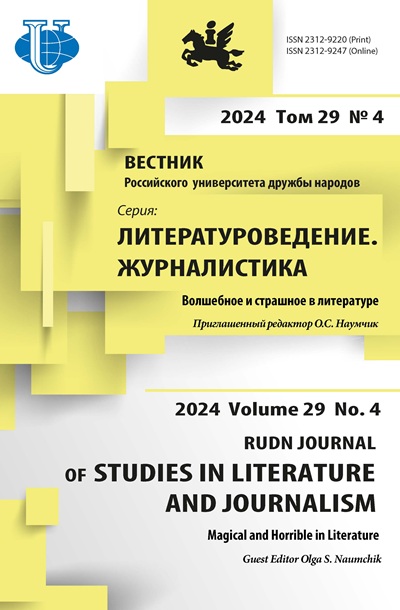Game principles of the art space's organization in D.W. Jones's novel Hexwood
- Authors: Naumchik O.S.1
-
Affiliations:
- Lobachevsky State University
- Issue: Vol 29, No 4 (2024): MAGICAL AND HORRIBLE IN LITERATURE
- Pages: 655-663
- Section: LITERARY CRITICISM
- URL: https://journals.rudn.ru/literary-criticism/article/view/42285
- DOI: https://doi.org/10.22363/2312-9220-2024-29-4-655-663
- EDN: https://elibrary.ru/PZRMGK
Cite item
Full Text
Abstract
The game principles of the art space's organization in D.W. Jones's novel Hexwood are considered. The aim of the study is to identify Hexwood`s game aspects in the context of fantasy's genre features in the XXth century`s second half. Objectives of the study are to formulate the game principles of the fantasy genre and to trace their realization in the novel. The general thesis is that the game's phenomenon has been actualized in literature and art at the compositional and thematic levels, which corresponds to the game culture's tradition. In fantasy, game features are particularly revealed, which allows us to distinguish three aspects of their consideration: game principles of secondary world creating, problem-themed field, intertextual play with pretexts. All of this points to great gaming potential of the fantasy. It is concluded that the space and the time in D.W. Jones's novel Hexwood become more complex and non-linear. It's also revealed several levels of associations and allusions to the Arthurian cycle. All personages are involved in the cyborg Bannus's game, based on the Arthurian tales, but in addition to their recognizable roles (Arthur, Merlin, Amfortas, etc.), almost all of the characters play other roles, not realized by them.
Keywords
About the authors
Olga S. Naumchik
Lobachevsky State University
Author for correspondence.
Email: naumchik@flf.unn.ru
ORCID iD: 0009-0009-3121-9420
PhD. in Philology, Professor at the Department of Foreign Literature
23 Gagarin Ave., Nizhny Novgorod, 603022, Russian FederationReferences
















